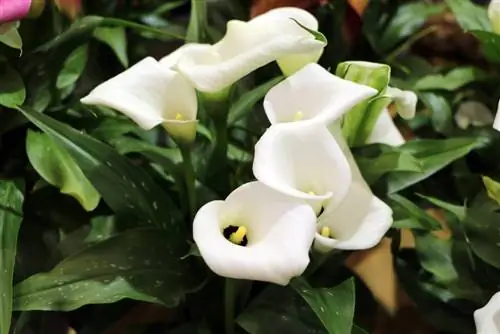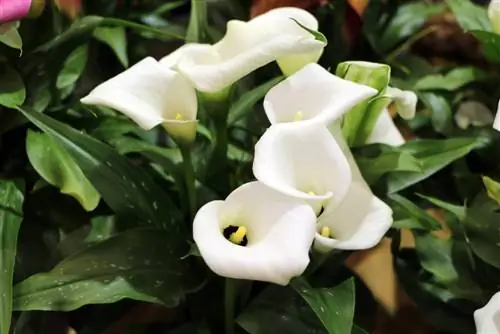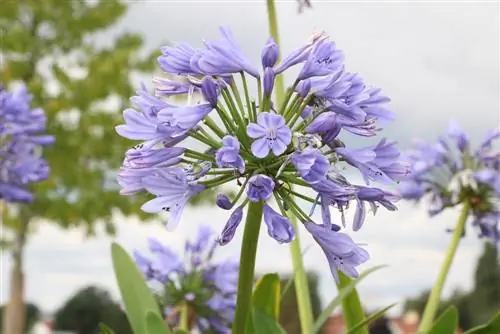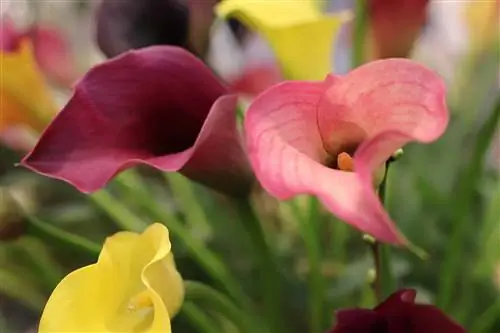- Author admin [email protected].
- Public 2023-12-17 03:39.
- Last modified 2025-01-24 12:45.
Zantedeschias are characterized by their characteristic flower: the actual flower spadix is surrounded by a colorful bract that includes almost all colors in the spectrum. Some species bloom in summer, others in winter.
However, proper care is always important for the plant, especially when it comes to the rest period. Because only when it finds conditions like those in its homeland will a calla bloom anew every year.
Profile
- Botanical name: Zantedeschia
- other names: calla, calla lily, zantedeschie, calla lily
- belongs to the arum family (Araceae)
- perennial, herbaceous plant
- Leaves: arrow-shaped, dark green (some species also speckled)
- Flowers: spadix with strikingly colored bract
- Flowering time: depending on the species either in summer or winter
- Growth height: 20-50 cm
Species and occurrence
All eight species of Zantedeschia are native to Africa. They are mainly found in the provinces of South Africa, but also grow further north. The summer-flowering species thrive in warm areas where it mainly rains in winter. In areas with summer rain, Zantedeschias (e.g. Zantedeschia aethiopica) bloom in winter. If an indoor calla is mentioned in the trade, this usually means that this species cannot tolerate frost. Different varieties according to flower color:
- Florex Gold: Yellow
- Pacific: dark pink
- Picasso: white bract with purple base
- Black Pearl: dark pink
Tip:
Callas are available in almost all colors. From pure white to creamy white, yellow, apricot, orange, light red, dark red, purple, pink, pink, violet to almost black and even two-tone.
Location
Caring for an indoor calla starts with the right location. Finding the optimal location is sometimes not that easy. On the one hand, the plant needs as much light as possible, but on the other hand, the leaves can easily burn if they are exposed to the midday sun. Locations above heating (or very warm locations overall) have an unfavorable effect on the flowering phase, which is significantly shorter at temperatures above 25 °C.
- Light requirement: very high (no midday sun)
- Temperature: Start of the growth phase between 12 and 15 °C
- Flowering phase: around 15-20 °C
- Soil: well-drained soil with a high compost content
Pouring
After the rest phase, you should initially water moderately. Before watering the next time, the soil must be completely dry. If the plant starts to grow stronger, slowly increase the watering until the leaves have fully developed. From this point on, the calla is given so much water that the root ball is permanently slightly moist. If flowers form, it is a good idea to place the entire pot in a saucer filled with water. As soon as the water has been absorbed, the coaster is refilled again. At the end of the flowering period, the amount of watering water is gradually reduced. If the leaves begin to dry out, watering should be stopped completely.
Tip:
There is no fixed schedule for watering the calla lilies. It is best to check the soil with your thumbs every few days. Over time you usually get a pretty good feeling for your water needs.
Care differences between Zantedeschia aethiopica and rehmannii
Zantedeschien occur naturally only in Africa. There they grow in swampy areas that dry out completely during drought periods. During this time the calla enters its resting phase. It dries up and drops all of its leaves. This rhythm must also be adhered to when the beautiful plant is cultivated indoors. When the Zantedeschia blooms depends on the rainy season in its homeland. Zantedeschia aethiopica is usually cultivated as a houseplant. The common calla usually blooms between January and April, and then goes into its dormant phase from May onwards.
Zantedeschia aethiopica (common calla lily)
- Rest phase: May to August
- can remain in the pot (protected from the rain outdoors)
- from September: water slowly again
- October to December: cool and bright location (12-15 °C)
- from January: 15-20 °C, lots of water
- sheltered from the wind
Tip:
New varieties such as Zantedeschia aethiopica Crowsborough can also be left outdoors in winter. They are hardy down to around -20 °C. In contrast to Zantedeschia aethiopica, Zantedeschia rehmannii, also called Rehmann calla, blooms in summer. They are therefore well suited as potted plants and can also be planted outdoors, but they have to be brought back indoors in winter.
Zantedeschia rehmannii (Pink Calla, Rehmann's Calla)
- Rest phase: October to March
- cut off all dried leaves
- Get the tuber out of the ground
- store on newspaper or in straw
- cool (frost-free) and dry (for example in the basement)
- pot again from March
- prefer in the room first
- start watering slowly
- can go outdoors again from mid-May
Fertilize
If the Zantedeschia begins to sprout again after the rest period, it is supplied with nutrients every 14 days with a liquid flowering plant fertilizer via the irrigation water. When the first flowers appear, fertilizing is increased to once a week. At the end of the flowering phase, stop fertilizing completely.
Cutting
When caring for the calla, pruning is only necessary to a very limited extent. In principle, it does not require any cutting at all. But the plant saves energy if dead shoots are cut out. The Zantedeschia then produces more and more new flowers.
Repotting
At the beginning of the growing season, a Zantedeschia aethiopica can be repotted into a larger planter if necessary. The root tuber (including rhizomes) is inserted a few centimeters deep into the substrate. The Rehmann calla is usually removed from the ground in autumn and replanted in spring.
- Time: Late summer
- Carefully dig out the root tuber
- Substrate: loose soil with a high compost content
- Insert the tuber in the same position
- Planting depth: 5 cm
- cover with substrate
- press carefully
- water lightly
- only put outdoors from mid-May
Propagate
If the Zantedeschia aethiopica has withered in autumn, larger plants can be propagated by division. The calla forms rhizomes that form on the side of the main tuber. Well-rooted side shoots can be separated with a sharp, clean knife and planted in separate pots. Growing from seeds also works, but it often takes years before the first flowering occurs. Rhizomes of the Rehmann calla are best divided before repotting in March.
Rest phase
The Zantedeschia aethiopica does not have its rest phase in winter, but in our summers. After the growth phase and flowering, the plant is best placed in a sunny place outdoors from May onwards. The sun can shine there for several hours a day because the plant has regressed to its underground parts. Important: Be sure to protect it from rain when you are resting! Since the plant absorbs almost no water during this time, the roots would quickly rot. Zantedeschia rehmanii is taken out of the ground in autumn and overwintered in a cool, dry place.
Tip:
A short rain shower during the rest period is completely unproblematic for the common calla lily. If it rains constantly, it must be placed in a dry place.
Diseases and pests
A Zantedeschia is susceptible to various diseases and pests. A good and clean substrate plays an important role. If this is of poor quality, pathogens such as fungi, viruses or bacteria can quickly be transferred to the plant. In this case, a suitable fungicide or pesticide should be used quickly. Aphids and spider mites can also be killed with home remedies.
Conclusion of the editors
A room calla is a very decorative plant, but is comparatively susceptible to diseases. If a lot of value is placed on good substrate and the rest phase is observed, it will give flowering plant lovers joy for a long time. Zantedeschia rehemannii or Zentedeschia aethiopica are better known as room calla. The plants originally come from Africa, mainly South Africa, and are notable for their uniquely shaped flowers.
What you should know about Zantedeschia soon
There are three different types of indoor calla, one winter-flowering and two summer-flowering. They differ in flowering time and root organs. The winter-flowering Zantedeschia aethiopica with its broad, white bracts has fleshy rhizomes. The other two species do not have rhizomes, but tubers.
Varieties by colors
- Zantedeschia ‘Black Magic’ Fluoro (Yellow),
- ‘Sunrise’ (Orange/Red),
- 'Pacific' and 'Pink Persuasion' (both dark pink),
- 'Mango' and 'Treasure' (both orange),
- ‘Dominique’ (Red),
- ‘Purple Heart’ ® (Violet)
- and 'Hot Chocolate' ® (purple almost black)
Location
- Zimmerkalla like a bright location, preferably in the sun.
- You can't have it too warm. They are not suitable for warm rooms. So the name is a bit misleading.
- Particularly during the growing season, temperatures around 15 °C are ideal.
- In summer you can put the indoor calla outside.
- It adapts to the temperatures, but should be placed protected from rain, because then it has its rest period.
- But before the first frosts she has to go back into the house, ideally in a protected room or a bright greenhouse.
Planting substrate
- A medium-heavy, humus-rich soil mixture is suitable as a plant substrate.
- You can use manure bed, compost or garden soil and mix it with peat and sand.
- If necessary, standard earth will do.
Watering and fertilizing
- During the growing season in winter and spring, the soil must be kept evenly moist.
- The rest period begins at the end of May, during which watering is severely restricted. The plant is kept almost dry.
- However, the rhizomes must not dry out completely. After repotting in July or August, add more water again.
- Water moderately and allow the soil to dry well between waterings.
- As the plants begin to grow more, increase the amount of water until the leaves are fully developed.
- At the beginning of flowering you can place the Zantedeschia in a saucer filled with water.
- When the flowering period comes to an end, watering is restricted. When the leaves turn yellow, stop it altogether.
- Fertilization is only carried out in winter and spring, i.e. during the growing season. A normal liquid fertilizer is well suited.
- You start as soon as the leaves of the Zantedeschia have fully developed and fertilize every 14 days.
- At the beginning of the flowering period, increase to a weekly nutrient dose.
Wintering
- If only the tubers or rhizomes are left, you can remove them from the soil.
- Let them dry for a while and then put them in a container with sand and keep them dry and frost-free.
- The basement is a good storage place.
Diseases and pests
- Room calla are susceptible to spider mites and aphids.
- Spider mites find ideal conditions to spread, especially during overwintering.






